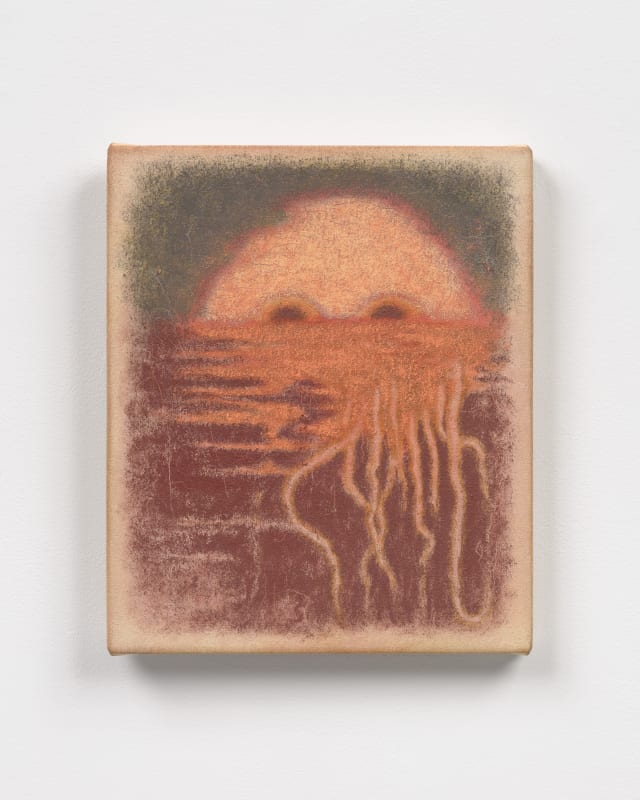BY EKIN ERKAN
From the antiquarian Ole Worm (1588–1654) to the naturalist Ferrante Imperato (ca. 1550–1625), up through William Blake (1757–1827) and modernists like Asger Jorn (1914–1973), John Graham (1881–1961), and Leonora Carrington (1917–2011), mythographic imagery has served as a replete foundation for visual artists trading on esoteric symbolism. Such pictorial content is eerie but identifiable. It might include floating eyeballs and organs plucked from medieval medical manuscripts or pages of cabbalistic numerology collocated from Aleister Crowley’s occultist periodical The Equinox (1909–1998). Culled from dusty kunstkammer shelves, the mystic’s motifs include anthropomorphic griffins, fauns, and sphinxes raptured in a Dionysian dance. Each artist who has imbibed from such ritual rites has had their unique motivations. Jorn’s mythography serviced Old Norse history and its polytheistic myths, setting his abstractions in contradistinction to his Helhesten and CoBrA compatriots. As articulated in the art theoretical principles of his System and Dialectics of Art (1937), Graham—a practitioner of Crowley’s Thelema—thought the truth of a painterly subject was best revealed via Jungian symbols. Martyn Cross’s exhibition at Marianne Boesky Gallery, All Shall Be Well—which takes its title from Julian of Norwich’s fourteenth-century book of mystical devotions, Revelations of Divine Love—is heir to this esoteric tradition.
Cross’s glowing, sandy paintings are partially inspired by the Mesozoic Era fossils darting the English Jurassic Coast, where the artist stayed in early 2023 as part of his term at the Hogchester Arts Residency. The content of Cross’s paintings is also roused by the myriad rare books that Cross paged through whilst working at a Bristol bookshop. The resultant paintings are curious and evocative. In Deep Stretch Dim (all works 2023), a detached ear services the outgrowth of a long, cavernous bugle from which unspools a cream crescent moon. The bugle, a medieval musical instrument, is paired with the organ that receives sound. Neither meaning nor narrative is lucid in this painting. Yet this is welcome, given that mysticism is set in stark opposition to rationality and logical understanding. Nevertheless, one can gesture towards some strand of connotation, cloaked though it is. The painting has to do with musicality, sound, and its rhapsody, bridged by the aural devices which license and receive it. In a particularly jocular work, Light Your Bone Fires, a moss-outlined hilltop smokes a bugle-cum-cigar, evincing the bugle as one of Cross’s recurrent motifs. Cross allows negative space to breathe in this charming-yet-harrowing work, whole pockets of worn-down pallid canvas pocked like roseate flesh. At 8 by 12 inches, the painting is the smallest of the bunch, but its simplicity belies Cross’s command of myth-molding.
For such an exhibition to be successful, the collective works must be correspondent to one another. That is, an exhibition of occultist paintings should read like an arcane parable shrouded in fog and written in a lost but fluent tongue. Shifting from one palette or style to another would undo the required fluidity. Cross is adroit on this point, exclusively hewing towards ocher, clay-red, and terra-cotta colors wrapped in thick, dusty outlines. Close inspection of works like The Sea Does Not Want You reveals sgraffito scratches. The painting sports a half-hidden sun with beady Stygian eyes veiled behind a cirrus foreground with corpulent roots. This piece, like so many others in Cross’s series, is painted in a flakey fog that, from afar, resembles craquelure. This technique makes the works quite successful, Cross’s paintings bedaubed in a weathered glow such that they resemble timeworn dry frescos. Deracinated body fingers are stitched into bleared, nebulous landscapes that froth into smoldering deserts and whispering waterfalls. Works like All Shall Be Well and The Sun Did Not Sing feature the occasional raven, feathers sloping into fingers. Cross clearly has developed a vernacular.
One is tempted to read the Freudian pictorial ideas of Surrealist progenitors like Max Ernst, Salvador Dalí, and Yves Tanguy into Cross’s loose attributions and connotative web-spinning. Ernst once characterized his work as a kind of collage, identifying the enterprise with "the meeting of two distant realities on a plane foreign to them both." Undoubtedly, Cross is a practitioner of such admixture. However, his work is thematically distant from the crisis of conscience and awareness that these Surrealists exhorted in the post-war period. For Cross, the anthropomorphization of nature and its inhabitants underwrites a self-serving mythos. Stylistically, his smoked and smudged landscapes are closer to André Masson’s mid-career “sea pictures” of Pontivy, Cecil Collins’s translucent mountains fitted with anthropoid owls, and Forrest Bess’s alchemy-suffused seascapes. With their dry-brushed pigments and weathered washes, Cross’s luminous paintings are ultimately self-contained, inspired but not derivative. Cross avoids the hackneyed motifs of straight-on horror and skirts the tropes of magical realism, humming a charmingly bizarre, idiosyncratic tune.


